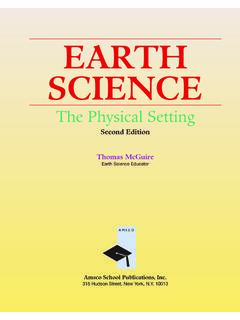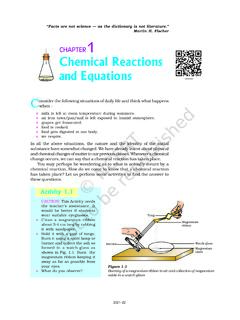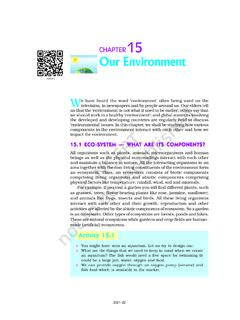Transcription of EARTH SCIENCE - Sarah Smith
1 EARTHSCIENCEThe physical SettingSecond EditionThomas McGuireEarth SCIENCE EducatorAmsco School Publications, Hudson Street, New York, 10013In addition to this book, Amsco School Publications, Inc. publishes thefollowing books written by Thomas McGuire:Reviewing EARTH SCIENCE : ThePhysical Setting, Third Edition; Laboratory and Skills Manual EARTH SCIENCE :The physical Setting; EARTH SCIENCE : Reviewing the book is dedicated to the thousands of students I have known in 32years of teaching. I hope they have learned nearly as much from me as Ihave from publisher would like to thank the following educators who reviewedthe K.
2 HardingLee KowalskyRetiredEarth SCIENCE TeacherNew York StateProctor Senior High SchoolEducation DepartmentUtica, New YorkJanet IadanzaDaniel B. Kujawinski, SCIENCE TeacherEducational ConsultantRockwood Park SchoolBrant, New YorkHoward Beach, New YorkCover Design:Meghan J. ShupeText Design:AGT/Howard PetlackComposition:Northeastern Graphic, :Hadel Studio and Northeastern Graphic, Photo:Eruption of the Eyjafjallajokull volcano in Iceland; Associated Press/Arnar Cover Photos:Left to right: Portage Glacier, Anchorage, Alaska; M 81galaxy in Ursa Major, courtesy of NASA; Raplee Anticline, Mexican Hat,Utah; North Clear Creek Falls in the San Juan Range of the RockyMountains, Colorado (Portage Glacier, Raplee Anticline, North ClearCreek Falls, courtesy of Thomas McGuire.)
3 Please visit our Web site ordering this book, please specifyR 797 HorEARTH SCIENCE : THE physical SETTING,SECOND EDITION, HARDBOUNDISBN 978-1-56765-946-7 New York City Number 56765-946-6 Copyright 2011 by Amsco School Publications, part of this book may be reproduced in any form without writtenpermission from the in the United States of America123456789101011121314To the StudentEarth SCIENCE : The physical Setting, Second Edition,which followsthe New York State Core Curriculum, which is based on NationalStandards, is an introduction to the study of EARTH SCIENCE . Thespecific standards covered in each chapter are listed in the tableof contents and next to the text to which they apply and next toeach Student Activity.
4 With this book, you can gain a firm under-standing of the fundamental concepts of EARTH SCIENCE a basefrom which you may confidently proceed to further studies in sci-ence and enjoy a deeper appreciation of the world around you. Youalso will need to become familiar with the 2010 EARTH SCIENCE Refer-ence Tables,a document prepared by the New York State EducationDepartment. You will find the individual tables within the appro-priate chapters of this text. You can obtain a copy of the entire doc-ument from your teacher or it can be downloaded from the StateEducation Web site: book is designed to make learning easier for you.
5 Manyspecial features that stimulate interest, enrich understanding, en-courage you to evaluate your progress, and enable you to reviewthe concepts are provided. These features include:1. Carefully selected, logically organized bookoffers an introductory EARTH SCIENCE course stripped of unnec-essary details that lead to confusion. It covers the New YorkState Core Curriculum for the physical Setting EARTH Clear understandable you willmeet many new scientific terms in this book, you will findthat the language is generally clear and easy to read. Eachnew term is carefully defined and will soon become part ofyour EARTH SCIENCE vocabulary.
6 The illustrations and pho-tographs also aid in your understanding, since they, like therest of the content, have been carefully designed to clarifyconcepts. Words in boldface are defined in place and in theGlossary. Words in italicsare important SCIENCE words youalready should know. iii 3. introductory section at the beginning ofeach chapter sets the stage for the rest of the chapter . Hereyou will find a list of Words to Know and the learning objec-tives for the Step-by-step solutions to problems followed by solving is presented logically, one step at a solutions to all types of EARTH SCIENCE problems areprovided.
7 These sample problems will help you approachmathematical problems logically. To enhance your newlyacquired skill, you will find practice problems followingmost sample Internet the chapters are the URLs, or Webaddresses, of various internet sites that provide additionalinformation or End-of- chapter review Regents-style, PartA, multiple-choice questions at the end of each chapter helpyou to review and assess your grasp of the content. Theopen-ended questions provide practice in answering ques-tions found in Part B and Part C of the Regents exam. Toanswer some of these questions you may need to refer to theEarth SCIENCE Reference Tablesor the tables found in A introduces you to laboratorysafety.
8 In Appendix B, you will be presented with a format to follow when preparing laboratory reports. Appendix Creviews the International System of Units. Appendix D lists the physical constants important to EARTH E explores the use of graphs in section contains all the boldfaced wordsfound in the text along with their study of EARTH SCIENCE can be both stimulating and chal-lenging. The author sincerely hopes that this book will increaseyour enjoyment of this TO THESTUDENTC ontentsUnit 1 EARTH Measures and Models11 SCIENCE AND Planet Earth21: MA 1, 2, 3; 1: SI 1, 2, 3; 1: ED 1; 2: IS 1, 2, 3; 6: ST 1; 6: M 2; 6: M 6: P of C 5; 6: O 6; 7: C 1; 7: S 2 What Is SCIENCE ?
9 / What Is EARTH SCIENCE ? / How Is EARTH ScienceRelated to Other sciences ? / Why Study EARTH SCIENCE ? / How DoScientists Gather and Analyze Information? / How Is DensityDetermined? / How Do Scientists Make and Use Graphs? / How IsTechnology Changing the Way Scientists Work?Student Activities:Good SCIENCE and Bad SCIENCE ; ExponentialNotation in the Real World; Making Estimations; Density of Solids;The Thickness of Aluminum Foil; Making a Graph of the Revolutionof the Planets; An Internet Scavenger Hunt2 EARTH s Dimensions and Navigation311: MA 1, 2, 3; 1: SI 3; 2: IS:1; 4: , d, f, i; 4: , 4: ;6: M 2; 6: M What Is EARTH s Shape?
10 / What Are EARTH s Parts? / How Is LocationDetermined?Student Activities:How Round Is EARTH ? Pie Graphs of EARTH sSpheres; Interpreting Reference Tables; Determining Your Latitude;Finding Solar Noon; Determining Your Longitude; Reading Latitudeand Longitude on Maps3 Models and Maps561: MA 1, 3; 1: SI 1; 1: ED 1; 2: IS 1 4: ; 6: ST 1; 6: M 2; 6: M 7: S 2 What Is a Model? / What Are Fields? / What Is a Topographic Map?Student Activities:Models in Daily Life; A Map to Your Home;Making a Water Compass; Characteristics of Isolines; A TemperatureField; Making a Topographic Model; Reading Your Local TopographicMap; A Profile on a Local Topographic Map; Interpreting Isoline Maps;Rescue and Evacuation PlanningUnit 2 Minerals, Rocks, and Resources844 INVESTIGATING Minerals851: MA 1; 1: SI 1, 3; 4: , b; 6: M 2 v What Are Minerals?







